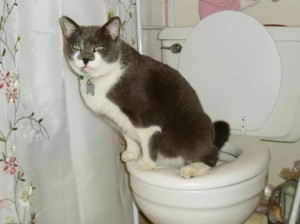Avoid Bathroom Emergencies: Don't Flush Cat Poop Down Your Toilet - Expert Advice
Avoid Bathroom Emergencies: Don't Flush Cat Poop Down Your Toilet - Expert Advice
Blog Article
What are your ideas concerning Don’t flush cat feces down the toilet?

Intro
As feline owners, it's important to be mindful of just how we get rid of our feline friends' waste. While it may appear convenient to purge cat poop down the bathroom, this practice can have damaging effects for both the atmosphere and human wellness.
Environmental Impact
Purging cat poop presents hazardous virus and parasites right into the water supply, presenting a significant danger to marine communities. These pollutants can adversely affect aquatic life and compromise water top quality.
Health Risks
In addition to ecological concerns, purging pet cat waste can also present health threats to human beings. Pet cat feces may consist of Toxoplasma gondii, a parasite that can cause toxoplasmosis-- a possibly extreme illness, particularly for pregnant women and people with damaged body immune systems.
Alternatives to Flushing
Luckily, there are more secure and a lot more responsible means to throw away pet cat poop. Think about the following alternatives:
1. Scoop and Dispose in Trash
One of the most typical method of throwing away cat poop is to scoop it right into a naturally degradable bag and toss it in the garbage. Make sure to make use of a committed litter scoop and throw away the waste promptly.
2. Usage Biodegradable Litter
Select naturally degradable pet cat trash made from materials such as corn or wheat. These trashes are eco-friendly and can be safely disposed of in the garbage.
3. Hide in the Yard
If you have a lawn, take into consideration hiding cat waste in a designated area far from vegetable yards and water sources. Make certain to dig deep enough to avoid contamination of groundwater.
4. Mount a Pet Waste Disposal System
Invest in an animal garbage disposal system especially designed for pet cat waste. These systems make use of enzymes to break down the waste, lowering odor and ecological influence.
Verdict
Accountable animal ownership extends past providing food and shelter-- it additionally entails correct waste administration. By refraining from purging pet cat poop down the bathroom and choosing alternative disposal approaches, we can lessen our environmental impact and secure human wellness.
Why Can’t I Flush Cat Poop?
It Spreads a Parasite
Cats are frequently infected with a parasite called toxoplasma gondii. The parasite causes an infection called toxoplasmosis. It is usually harmless to cats. The parasite only uses cat poop as a host for its eggs. Otherwise, the cat’s immune system usually keeps the infection at low enough levels to maintain its own health. But it does not stop the develop of eggs. These eggs are tiny and surprisingly tough. They may survive for a year before they begin to grow. But that’s the problem.
Our wastewater system is not designed to deal with toxoplasmosis eggs. Instead, most eggs will flush from your toilet into sewers and wastewater management plants. After the sewage is treated for many other harmful things in it, it is typically released into local rivers, lakes, or oceans. Here, the toxoplasmosis eggs can find new hosts, including starfish, crabs, otters, and many other wildlife. For many, this is a significant risk to their health. Toxoplasmosis can also end up infecting water sources that are important for agriculture, which means our deer, pigs, and sheep can get infected too.
Is There Risk to Humans?
There can be a risk to human life from flushing cat poop down the toilet. If you do so, the parasites from your cat’s poop can end up in shellfish, game animals, or livestock. If this meat is then served raw or undercooked, the people who eat it can get sick.
In fact, according to the CDC, 40 million people in the United States are infected with toxoplasma gondii. They get it from exposure to infected seafood, or from some kind of cat poop contamination, like drinking from a stream that is contaminated or touching anything that has come into contact with cat poop. That includes just cleaning a cat litter box.
Most people who get infected with these parasites will not develop any symptoms. However, for pregnant women or for those with compromised immune systems, the parasite can cause severe health problems.
How to Handle Cat Poop
The best way to handle cat poop is actually to clean the box more often. The eggs that the parasite sheds will not become active until one to five days after the cat poops. That means that if you clean daily, you’re much less likely to come into direct contact with infectious eggs.
That said, always dispose of cat poop in the garbage and not down the toilet. Wash your hands before and after you clean the litter box, and bring the bag of poop right outside to your garbage bins.
https://trenchlesssolutionsusa.com/why-cant-i-flush-cat-poop/

We hope you enjoyed our section about Don’t flush cat feces down the toilet. Thanks so much for taking time to read our content. Appreciated our review? Please share it. Let others discover it. We appreciate reading our article about How to Dispose of Cat Poop and Litter Without Plastic Bags.
Visit Our Site Report this page